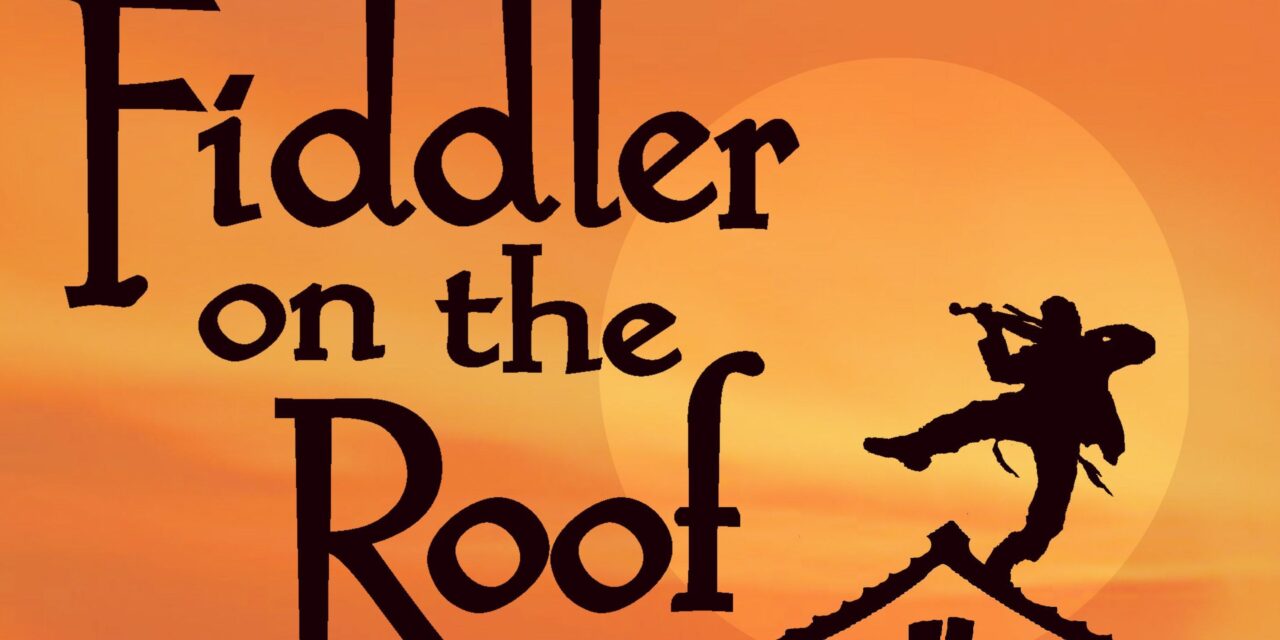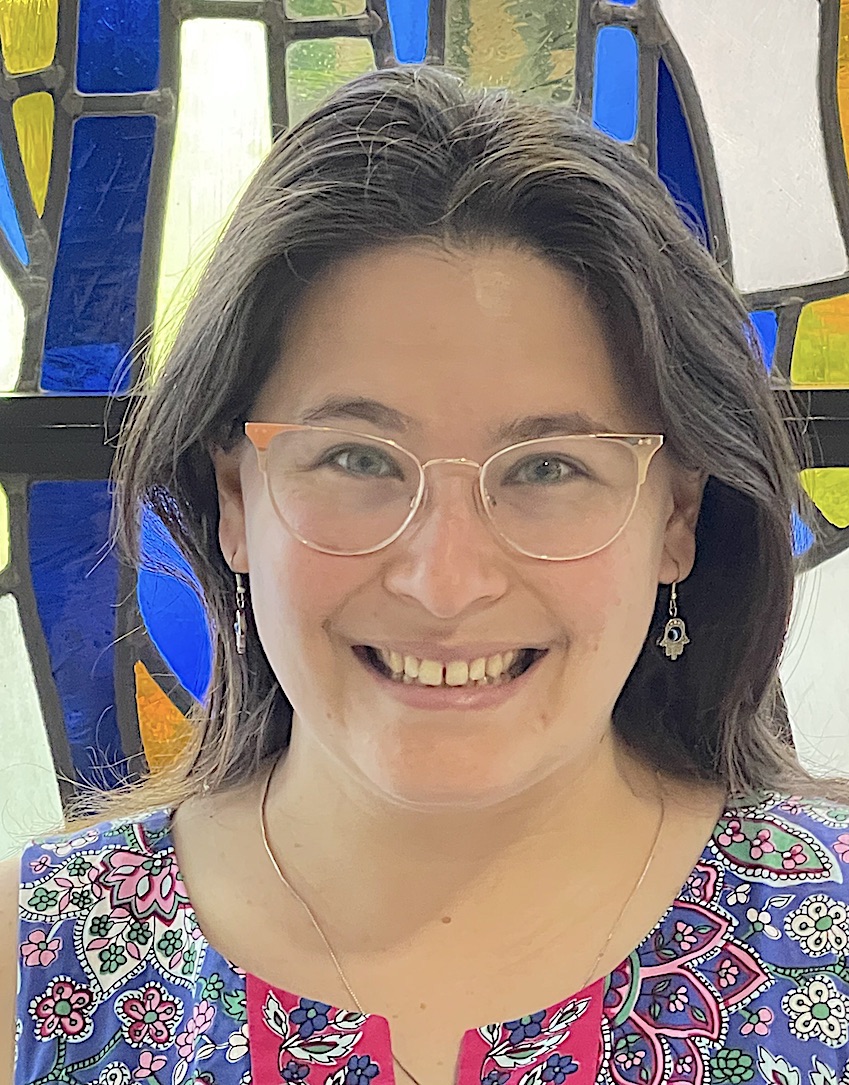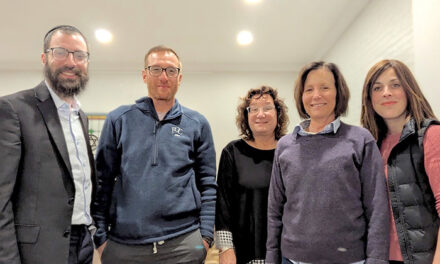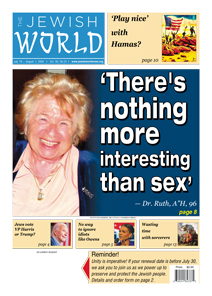By MARILYN SHAPIRO
A man in a red parka walks onto the stage, and intones the iconic first lines: “A fiddler on roof? Sounds crazy, no?” As he sheds his modern jacket and the first violin notes sound, he transforms into Tevye the Dairyman. Through “Tradition,” the opening number, he introduces life in his tiny village of Anatevka.
Is it a working stiff Jew who balances on the roof and tries to make life musical? Or is it the Messiah?
Nearly 60 years after its 1964 Broadway opening, a revival of Fiddler on the Roof is coming to Proctors in Schenectady on Wednesday and Thursday, April 26-27, with a fresh approach and a cast worthy of its long tradition of smiles and tears.
Composer Jerry Bock’s and lyricist Sheldon Harnick’s musical is based on Tevye the Dairyman, by Yiddish writer Sholom Aleichem. Set in 1905 in Czarist Russia, Tevye struggles with the untraditional courtships of the three oldest of his five daughters while facing social and political changes that threaten his beliefs, community, and tradition.
Smiles, tears, and the end
In addition to the joys (and craziness) of family relationships, religious questioning, and sentimentality, the show is about the death of a way of life. This was due to changes in technology, economics, and other social conditions… including pervasive suspicion and hatred of Jews. Yet, like the show’s protagonists, in this season between Pesach and Shavuos, we hope for rebirth, redemption, and law-based morality.
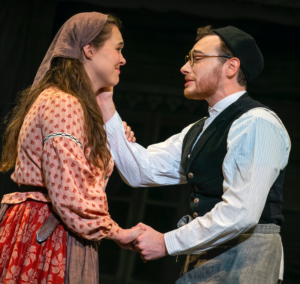
Randa Meierhenry (Tzeitel) and Daniel Kushner (Motel the poor taylor). Photo by Joan Marcus.
We still yearn for an end to persecution, violence, bigotry, demagoguery, and the disingenuousness, deception, and two-facedness in our politics and public discourse. From Pharaoh’s Egypt to the desert to the Promised Land…to Russia…to the good ol’ USA…what has changed? Our pleasant and secure “shtetl” in America is threatened by the flaming tides of simmering hatreds, burgeoning civil unrest, and random murders.
Since 2015, Fiddler has taken on a new face as Tony-award-winning director Bartlett Sher brings his own vision. The show has stunning new movement and dance by Israeli choreographer Hofesh Shechter. Although Jerome Robbins’ stamp remains on the key numbers, including the famous bottle dance, the Israeli’s roots and background result in earthier, raw dance numbers which garnered him a 2016 Tony.
In recent phone calls with the actors playing the irrepressible Bible-quoting Tevye and his loving but nagging wife, Golde, I learned more about the updated production as well as the impact the roles have had on the two leads.
Roots in Holocaust
Jonathan Hashmonay may be one of the youngest actors to professionally play the role of Tevye, but he makes up for his age with life experience and talent. The descendent of Polish Holocaust survivors, Hashmonay grew up in Israel. Throughout his youth, he performed in many high school ensembles and bands as well as Yom HaZikaron (Day of Remembrance) and Yom Haatzmaut (Independence Day) ceremonies. Although his family moved to New Jersey when he was 13, he returned to serve in the Israeli Defense Force, where he was the lead singer in the IDF’s Ground Forces Band. The group performed for audiences ranging from a small group of soldiers in the Negev to the prime minister and world dignitaries.
Hashmonay originally planned on following in the footsteps of his father, a doctor. Interest piqued by seeing musical productions including Book of Mormon, however, led him to Penn State University, where he majored in musical theater.
In 2021, Hashmonay joined the Fidder tour in the role of Avram the bookseller. He also was an understudy for Tevye, and he got to play the role five times.When the opportunity arose for him to step into the lead in 2022, he gladly accepted.
Acting truth
Hashmonay said, “I try my best to be very truthful Tevye. I want to portray a sweet, loving family man whose life becomes increasingly difficult.” Hashmonay felt it was important that the dairyman’s gait reflected the increasing weight of family responsibilities and of the tragedies that befall in Jewish Russian family.
As many of the Tevyes before him, Hashmonay enjoys performing the show-stopping “If I Were a Rich Man.” On the other hand, he finds poignancy and pathos in a second act scene where Chava, his third daughter, first reveals her love for Fyedke, a non-Jew. The two strong-willed people engage in a fierce battle of wits. Tevye tries desperately to warn her of the consequences:“A bird may love a fish, but where would they build a home together?” Chava just as passionately defends her choice. “The world is changing, Papa!”
When Tevye and Golde learn that their daughter and the Russian were married by a priest, it is one step too far for the besieged father. It is the biggest affront to the tradition that keeps Tevye, like the fiddler on the roof, balanced in a world that is crashing around him. “We have other children at home,” he tells his wife. “Chava is dead to us.” Hashmonay said he is most touched by “Chavalah,” the song and ballet number in which Tevye relives the special moments in his now-lost child’s life.
Researching Golde
Maite Uzal, a native of Madrid, Spain, continues in her role as Golde, which she performed over 850 times since 2018. In order to understand her character, Uzal researched early twentieth-century Eastern European Jewish life in which Fiddler is set. Uzal grew to respect and pity the exhausting responsibilities of the women who kept a “proper home, a quiet home, a kosher home.”
Uzal’s realization that Golde, like most Jewish women at the time, was illiterate, “hit me like a hammer in the head,” she said. “The way you process the world when you don’t read is so different,” Uzal commented. “All her information came from her religion, her superstitions, and what she heard from others.”
As Uzal herself has no children, being the “mother” of five daughters was also a learning experience, bringing her to the realization that parenthood is relentless, unconditional, and all-encompassing. “I am an even better daughter to my mother,” she said laughing.
Followed her heart
Personally, Uzal compared her life experiences to Hodel, the second daughter. Uzal completed law school and served as a litigator in Spain. Twelve years ago, however, her passion for theater led her to leave law, abandon her home in Spain, and live—like Hodel— “far from the home I love.” “I defied my family, especially my father, and left the people and traditions I know — to follow my heart,” she said.
“My father was initially very angry that I chose to leave my profession as a lawyer and my country. In his eyes, I was not Golde—who followed tradition— I was Chava.” As Tevye comes around in the last moments of Fiddler, Uzal and her father later reconciled.
Uzal applied to the highly competitive Musical Theatre Conservatory Program at the American Musical and Dramatic Academy in New York City.“I knew if I was accepted there, I would have the background to succeed.” She found that success upon her graduation, landing roles in Les Miz, In the Heights, and Lion King.
Both Hashmonay and Uzal spoke of the universal themes of Fiddler. “Every culture wants to define themselves by their traditions,” said Uzal, “and every culture’s children want to defy them.” They also see the plight of today’s refugees—Syrians and Ukrainians—reflected in Fiddler.
Hashmonay praised Fiddler’s themes of love, family, resilience, and change created from the tides of outside forces. “Our world—just like Tevye’s— is changing drastically,” noted Hashmonay. “Traditions that are so important are being pushed aside. How do we decide which of those changes to accept or not?”
At the end of Act II, Tevye again dons the red coat, and he, Golde, and the cast talk about the struggle of the Ukrainians and the world’s growing anti-Semitism.
“As much as The Diary of Anne Frank is not just a Jewish story, neither is Fiddler on the Roof,” wrote Barbara Isenberg in Tradition!, her chronicle of the making of the popular musical. “Fiddler’s strong themes of family, tradition, repression, prejudice, and diaspora continue to evoke common ground for its audiences wherever they are.”

